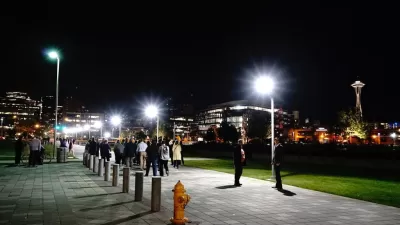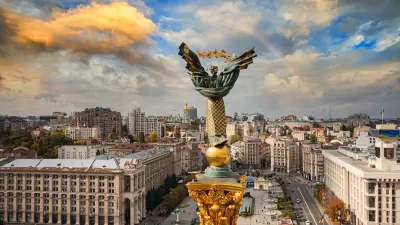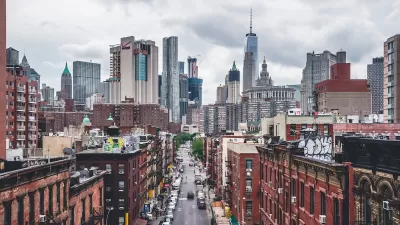Cities are sized-up, measured and analyzed in countless ways. The Economist uses statistics to indicate how New York’s financial sector is faring against its London counterpart. Richard Florida measures the extant of the creative class. Allan Jacobs carefully records intersection densities and Jan Gehl simply counts pedestrians. Some, like Peter Calthorpe, go beyond the city line and take stock of the whole region.
Cities are sized-up, measured and analyzed in countless ways.
The Economist uses statistics to
indicate how New York's financial sector is
faring against its London
counterpart. Richard Florida measures the extant of the creative class. Allan Jacobs carefully records
intersection densities and Jan Gehl simply counts pedestrians. Some, like Peter
Calthorpe, go beyond the city line and take stock of the whole region.
Calculating all of the above certainly yields an understanding
of urban complexities, but the more abstract element of pride is interesting as well.
All great cities have pride. Pride may be defined as urban denizens recognizing
and expressing a connection to each other and their city. It might also include
how residents favorably compare themselves and their city to others. In other words, pride is identity. It engenders a bit of swagger and for residents and visitors alike, it can be
seen, felt or heard. When genuine, pride is very marketable.
Pride is typically derived from a common element, which like
good urbanism, is specific to the unique quality of place. Sometimes
it is manifested in something conspicuous, like Millennium
Park in Chicago,
although often it is not so tangible, like the can-do underdog spirit
reclaiming small swaths of ever-maligned Detroit.
An exemplar case is Boston.
Win or lose, the city's maniacal love affair with the Red Sox, (and sports in
general) lock people of all persuasions into a running discussion for much of
the year. In fact, besides the ever-changing weathah' it's the one thing cab drivers from East
Boston and high-powered bankers from Weston can bandy over. Thus,
the Red Sox define an unspoken camaraderie amongst residents, which is manifested
in the display of pride and what it means to be from Boston.

Austin's SOCO district is a homegrown source of pride.
City pride is also readily on display in Austin, Texas.
Though less concrete than a sports team, the good people of this "batty" city
willfully fashion themselves as a blue dot in a red state. Indeed, a bumper
sticker slogan readily reminds citizens to "Keep Austin Weird." This catchphrase
has become a rallying cry of sorts and a self-fulfilling prophecy locals love
to perpetuate. Spend a few days there and one realizes there is a lot of pride
wrapped up in Austin's
unique indie culture, cuisine and political leanings. It's what makes Austin, Austin.
Pride is often maximized in a time of crisis. It kept New
Orleans singing after the floods and encouraged New Yorkers, if not the world,
to make New York City post-9/11 better than ever before. Are there two better
American cities?
As The Economist
would note, pride also invokes healthy competition in everything from financial
markets to futbol. Barcelona and Madrid constantly vie
for Spanish supremacy, and as a result push each other to new heights in other
Euro-centric and increasingly global realms.
Pride can be inherent. Parisans have tremendous reverence
for their history, dialect, city and local culture. If you've been chastised
for not speaking "zee French" while visiting, you know what I mean. However,
you will also understand that from Montmarte to Montparnasse
being unapologetically Parisian is what prevents the city from becoming a
museum.
As a final example, a thriving institution can embody city
pride as well. The small city of Ann Arbor, for
example, maintains an incredible symbotic relationship with the University of Michigan and all of its wonderful
attributes. The duality of city and university offer a cultural oasis in a
desert of cornfields, which creates a unique cohesion among residents, students
and alumni. Though they tend to spread out around the world, this community can
always reconnect with the Ace Deuce when hearing ‘Hail, Hail, to Michigan, the leaders
and the best!'
Here in Miami,
an extremely diverse and transient city, there is very little pride exhibited.
It's a fragmented metropolis
with little recognition of its own history or an operable central core in which people connect. In short, there is no sense of civitas. Yet, if one
peers below the surface, pockets of cohesion and community pride do exist. Little
Havana, the
city's burgeoning upper-east side neighborhood and Coconut Grove are good
examples. However, there is some magic missing in the "Magic City."
Clearly, there is a given social contract within cities that
people must embrace, adopt or reject. Not all Bostonians follow the Red Sox
with fervor, nor does every Michigan alumn
look back on their days in Ann Arbor
with misty eyes. Nonetheless, pride is a
building block to greatness that cities accrue organically, and if smart, cultivate deliberately.

Planetizen Federal Action Tracker
A weekly monitor of how Trump’s orders and actions are impacting planners and planning in America.

DARTSpace Platform Streamlines Dallas TOD Application Process
The Dallas transit agency hopes a shorter permitting timeline will boost transit-oriented development around rail stations.

Congressman Proposes Bill to Rename DC Metro “Trump Train”
The Make Autorail Great Again Act would withhold federal funding to the system until the Washington Metropolitan Area Transit Authority (WMATA), rebrands as the Washington Metropolitan Authority for Greater Access (WMAGA).

Supreme Court Ruling in Pipeline Case Guts Federal Environmental Law
The decision limits the scope of a federal law that mandates extensive environmental impact reviews of energy, infrastructure, and transportation projects.

Texas State Bills to Defund Dallas Transit Die
DART would have seen a 30% service cut, $230M annual losses had the bills survived.

Bikeshare for the Win: Team Pedals to London Cricket Match, Beats Rivals Stuck in Traffic
While their opponents sat in gridlock, England's national cricket team hopped Lime bikes, riding to a 3-0 victory.
Urban Design for Planners 1: Software Tools
This six-course series explores essential urban design concepts using open source software and equips planners with the tools they need to participate fully in the urban design process.
Planning for Universal Design
Learn the tools for implementing Universal Design in planning regulations.
Roanoke Valley-Alleghany Regional Commission
City of Mt Shasta
City of Camden Redevelopment Agency
City of Astoria
Transportation Research & Education Center (TREC) at Portland State University
US High Speed Rail Association
City of Camden Redevelopment Agency
Municipality of Princeton (NJ)






























